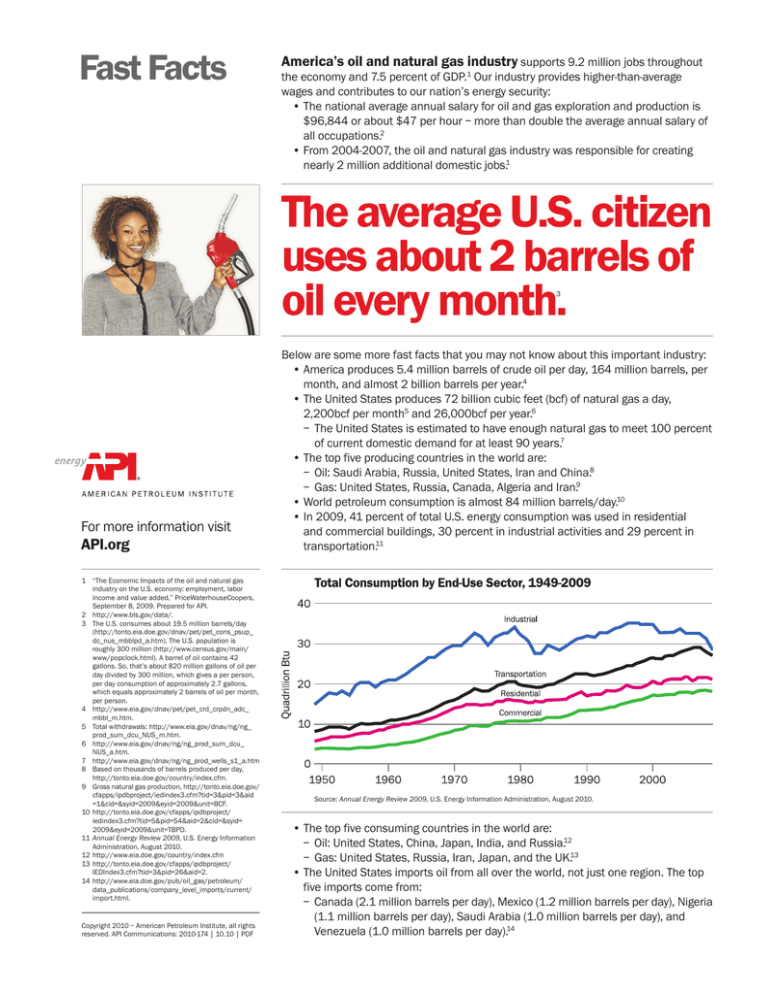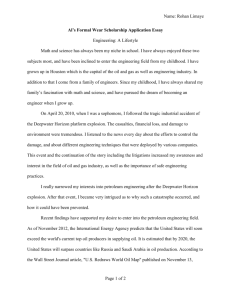
Fast Facts
America’s oil and natural gas industry supports 9.2 million jobs throughout
the economy and 7.5 percent of GDP.1 Our industry provides higher-than-average
wages and contributes to our nation’s energy security:
• The national average annual salary for oil and gas exploration and production is
$96,844 or about $47 per hour – more than double the average annual salary of
all occupations.2
• From 2004-2007, the oil and natural gas industry was responsible for creating
nearly 2 million additional domestic jobs.1
The average U.S. citizen
uses about 2 barrels of
oil every month.
3
For more information visit
API.org
1 “The Economic Impacts of the oil and natural gas
industry on the U.S. economy: employment, labor
income and value added,” PriceWaterhouseCoopers,
September 8, 2009. Prepared for API.
2 http://www.bls.gov/data/.
3 The U.S. consumes about 19.5 million barrels/day
(http://tonto.eia.doe.gov/dnav/pet/pet_cons_psup_
dc_nus_mbblpd_a.htm). The U.S. population is
roughly 300 million (http://www.census.gov/main/
www/popclock.html). A barrel of oil contains 42
gallons. So, that’s about 820 million gallons of oil per
day divided by 300 million, which gives a per person,
per day consumption of approximately 2.7 gallons,
which equals approximately 2 barrels of oil per month,
per person.
4 http://www.eia.gov/dnav/pet/pet_crd_crpdn_adc_
mbbl_m.htm.
5 Total withdrawals: http://www.eia.gov/dnav/ng/ng_
prod_sum_dcu_NUS_m.htm.
6 http://www.eia.gov/dnav/ng/ng_prod_sum_dcu_
NUS_a.htm.
7 http://www.eia.gov/dnav/ng/ng_prod_wells_s1_a.htm
8 Based on thousands of barrels produced per day,
http://tonto.eia.doe.gov/country/index.cfm.
9 Gross natural gas production, http://tonto.eia.doe.gov/
cfapps/ipdbproject/iedindex3.cfm?tid=3&pid=3&aid
=1&cid=&syid=2009&eyid=2009&unit=BCF.
10 http://tonto.eia.doe.gov/cfapps/ipdbproject/
iedindex3.cfm?tid=5&pid=54&aid=2&cid=&syid=
2009&eyid=2009&unit=TBPD.
11 Annual Energy Review 2009, U.S. Energy Information
Administration, August 2010.
12 http://www.eia.doe.gov/country/index.cfm
13 http://tonto.eia.doe.gov/cfapps/ipdbproject/
IEDIndex3.cfm?tid=3&pid=26&aid=2.
14 http://www.eia.doe.gov/pub/oil_gas/petroleum/
data_publications/company_level_imports/current/
import.html.
Copyright 2010 – American Petroleum Institute, all rights
reserved. API Communications: 2010-174 | 10.10 | PDF
Below are some more fast facts that you may not know about this important industry:
• America produces 5.4 million barrels of crude oil per day, 164 million barrels, per
month, and almost 2 billion barrels per year.4
• The United States produces 72 billion cubic feet (bcf) of natural gas a day,
2,200bcf per month5 and 26,000bcf per year.6
– The United States is estimated to have enough natural gas to meet 100 percent
of current domestic demand for at least 90 years.7
• The top five producing countries in the world are:
– Oil: Saudi Arabia, Russia, United States, Iran and China.8
– Gas: United States, Russia, Canada, Algeria and Iran.9
• World petroleum consumption is almost 84 million barrels/day.10
• In 2009, 41 percent of total U.S. energy consumption was used in residential
and commercial buildings, 30 percent in industrial activities and 29 percent in
transportation.11
Source: Annual Energy Review 2009, U.S. Energy Information Administration, August 2010.
• The top five consuming countries in the world are:
– Oil: United States, China, Japan, India, and Russia.12
– Gas: United States, Russia, Iran, Japan, and the UK.13
• The United States imports oil from all over the world, not just one region. The top
five imports come from:
– Canada (2.1 million barrels per day), Mexico (1.2 million barrels per day), Nigeria
(1.1 million barrels per day), Saudi Arabia (1.0 million barrels per day), and
Venezuela (1.0 million barrels per day).14
The Industry
Over the last five years, earnings for the oil and natural gas industry have been
5.0%
Other Institutional
Investors
Contrary to popular belief and what some critics might say, America’s oil companies
aren’t owned by a small group of wealthy investors.
• Only 1.5 percent of industry shares are owned by corporate management.
The rest is owned by tens of millions of Americans.15
• If you are part of the 55 million U.S. households with a mutual fund, or the
45 million with personal retirement accounts, there is a good chance you
invest in oil and natural gas stocks.15
• Since 2000, the oil and natural gas industry has invested $1.7 trillion in
U.S. capital projects to advance all forms of energy, including alternatives,
while reducing the industry’s environmental footprint.16
• Between 2000 and 2008, the industry invested more than $58 billion in
new low and zero carbon emissions technologies.17
14.0%
IRAs
27.0%
Pension Funds
1.5%
Corporate Management
of Oil Companies
29.5%
Mutual Funds
and Other Firms
23.0%
Individual
Investors
Source: The Distribution of Ownership
of U.S. Oil and Natural Gas Companies,
SONECON, September 2007.
in line with U.S. manufacturing – averaging just 7 cents for every dollar of sales.15
Challenges facing the
industry could mean fewer
jobs...
There are those in Congress who want to raise taxes on only American oil and natural
gas companies, despite the fact that they already have an effective tax rate higher
than other S&P Industrials.15
Income Tax Expenses as Share of Net Income Before Income Taxes
(2009)
48.4%
Oil and
Natural Gas
Companies18
28.1%
S&P Industrials
Excluding Oil
and Natural Gas
Companies19
For more information visit
API.org
Source: Compustat North America Database (January 2010 update).
API represents more than 400
oil and natural gas companies,
leaders of a technology-driven
industry that supplies America’s
energy.
15 http://www.api.org/statistics/earnings/upload/
earnings_perspective.pdf.
16 Oil & Gas Journal, March 1, 2010.
17 http://www.api.org/aboutoilgas/upload/
Energizing_America_Facts.pdf.
18 Oil and gas extraction (NAICS 211) and petroleum
refining (NAICS 32411).
19 Excludes companies engaged in oil and gas extraction
(NAICS 211) and petroleum refining (NAICS 32411).
20 http://www.api.org/Newsroom/taxes-hurt-oil-prod.cfm,
API calculations based on Wood Mackenzie study.
21 http://press.ihs.com/article_display.cfm?article_
id=4297.
22 http://www.api.org/Newsroom/voters-opposetaxes.cfm.
23 http://www.api.org/Newsroom/taxes-hurt-oilprod.cfm.
Copyright 2010 – American Petroleum Institute, all rights
reserved. API Communications: 2010-174 | 10.10 | PDF
• Repealing the job-creating Section 199 domestic manufacturing tax deduction
and denying the deductibility of intangible drilling costs will place 58,800 jobs at
risk in 2011 and 165,000 by 2012.20
• Additional taxes on foreign earnings could compromise the ability of U.S. oil and
natural gas companies to compete in the global marketplace and invest in the U.S.21
• The public opposes increased taxes on oil and natural gas companies. According
a recent poll among 6,000 registered voters, 64 percent in 10 states oppose an
increase in oil and gas taxes, including 46 percent of voters who strongly oppose.22
...and place our nation’s energy
security at risk.
• Studies show that with some of these tax proposals, the potential loss of domestic
production could be as high as 600,000 barrels of oil equivalent per day, placing
$15 billion in capital at risk in 2011 and almost $130 billion over the next ten
years.23
• In the first year of tax changes, approximately 1 percent of oil and 5 percent of
natural gas production is at risk.23






